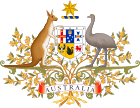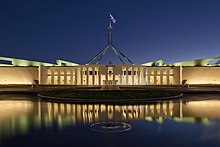
The governor-general of Australia is the representative of the monarch, currently King Charles III, in Australia. The governor-general is appointed by the monarch on the recommendation of the prime minister. The governor-general has formal presidency over the Federal Executive Council and is commander-in-chief of the Australian Defence Force. The functions of the governor-general include appointing ministers, judges, and ambassadors; giving royal assent to legislation passed by parliament; issuing writs for election; and bestowing Australian honours.

The prime minister of Australia is the head of government of the Commonwealth of Australia. The prime minister heads the executive branch of the federal government of Australia and is accountable to federal parliament under the principles of responsible government. The prime minister is the chair of the federal cabinet and the national cabinet and a member of the federal executive council. The current prime minister is Anthony Albanese of the Australian Labor Party, who assumed the office on 23 May 2022.

The Executive Council of New Zealand is the full group of "responsible advisers" to the governor-general, who advise on state and constitutional affairs. All government ministers must be appointed as executive councillors before they are appointed as ministers; therefore all members of Cabinet are also executive councillors. The governor-general signs a warrant of appointment for each member of the Executive Council, and separate warrants for each ministerial portfolio.

The King's Privy Council for Canada, sometimes called His Majesty's Privy Council for Canada or simply the Privy Council (PC), is the full group of personal consultants to the monarch of Canada on state and constitutional affairs. Practically, the tenets of responsible government require the sovereign or his viceroy, the governor general of Canada, to almost always follow only that advice tendered by the Cabinet: a committee within the Privy Council composed usually of elected members of Parliament. Those summoned to the KPC are appointed for life by the governor general on the advice of the prime minister of Canada, meaning that the group is composed predominantly of former Cabinet ministers, with some others having been inducted as an honorary gesture. Those in the council are accorded the use of an honorific style and post-nominal letters, as well as various signifiers of precedence.
The Executive Council was the cabinet and de facto executive branch of government of the 1922–1937 Irish Free State. Formally, executive power was vested in the Governor-General on behalf of the King. In practice, however, it was the Council that governed, since the Governor-General was bound to act on its advice. The Executive Council included a prime minister called the President of the Executive Council and a deputy prime minister called the Vice-President. A member of the Council was called an executive minister, as distinct from an extern minister who had charge of a department without being in the Council.
The Cabinet of Australia, officially the Cabinet of the Commonwealth of Australia, also known as the Federal Cabinet, is the chief decision-making body of the executive branch of the federal government of Australia. The cabinet is appointed by the prime minister of Australia and is composed of senior government ministers who head the executive departments and ministries of the federal government, this often includes assistant ministers and a number of special envoys and other government advisors. The cabinet is separate to the federal Department of the Prime Ministers and Cabinet.

The Executive Council of Alberta is a body of ministers of the Crown in right of Alberta, who along with the lieutenant governor, exercises the powers of the Government of Alberta. Ministers are selected by the premier and typically sit as a member of the Legislative Assembly (MLA). It is the provincial equivalent to the federal Cabinet of Canada.

Ministers in the New Zealand Government are members of Parliament (MPs) who hold ministerial warrants from the Crown to perform certain functions of government. This includes formulating and implementing policies and advising the governor-general. Ministers collectively make up the executive branch of the New Zealand state. The governor-general is obliged to follow the advice of the prime minister on the appointment and dismissal of ministers.
The Australian Government, also known as the Commonwealth Government, is the national government of Australia, a federal parliamentary constitutional monarchy. The government consists of the parliamentary members of the party or coalition that currently has the support of a majority of members of the House of Representatives and in some contexts also includes the departments and other executive bodies ministers oversee. The current government consists of Anthony Albanese and other Australian Labor Party parliamentarians, in place since the 2022 federal election.
The government of Alberta is the body responsible for the administration of the Canadian province of Alberta. As a constitutional monarchy, the Crown—represented in the province by the lieutenant governor—is the corporation sole, assuming distinct roles: the executive, as the Crown-in-Council; the legislature, as the Crown-in-Parliament; and the courts, as the Crown-on-the-Bench. The functions of the government are exercised on behalf of three institutions—the Executive Council; the Legislative Assembly; and the judiciary, respectively. Its powers and structure are partly set out in the Constitution Act, 1867.

The Vice-President of the Executive Council is the minister in the Government of Australia who acts as the presiding officer of meetings of the Federal Executive Council when the Governor-General is absent. The Vice-President of the Executive Council is appointed by the Governor-General on the advice of the Prime Minister of Australia, and serves at the Governor-General's pleasure. The Vice-President is usually a senior minister in Cabinet, who may summon executive councillors and preside at council meetings when the Governor-General is not present. However, the Vice-President cannot sign Executive Council documents on behalf of the Governor-General.

The government of Ontario is the body responsible for the administration of the Canadian province of Ontario. A constitutional monarchy, the Crown—represented in the province by the lieutenant governor—is the corporation sole, assuming distinct roles: the executive, as the Crown-in-Council; the legislature, as the Crown-in-Parliament; and the courts, as the Crown-on-the-Bench. The functions of the government are exercised on behalf of three institutions—the Executive Council; the Provincial Parliament ; and the judiciary, respectively. Its powers and structure are partly set out in the Constitution Act, 1867.
The King-in-Council or the Queen-in-Council, depending on the sex of the reigning monarch, is a constitutional term in a number of states. In a general sense, it refers to the monarch exercising executive authority, usually in the form of approving orders, on the advice of the country's privy council or executive council.
An executive council is a constitutional organ found in a number of Commonwealth countries, where it exercises executive power and (notionally) advises the governor, governor-general, or lieutenant governor, and will typically enact decisions through an Order in Council. In several Commonwealth countries, the executive council is usually referred to as the cabinet. However, the use of the word cabinet as a synonym for the executive council is not universally practised throughout the Commonwealth of Nations, with some Commonwealth countries using the term cabinet to refer to a distinct group of high-ranking officials.

Australia is a federal parliamentary constitutional monarchy. The country has maintained a stable liberal democratic political system under its Constitution, the world's tenth oldest, since Federation in 1901. Australia is the world's sixth oldest continuous democracy and largely operates as a two-party system in which voting is compulsory. The Economist Intelligence Unit rated Australia a "full democracy" in 2022. Australia is also a federation, where power is divided between the federal government and the states and territories.
The Executive Council of New South Wales is the cabinet of that Australian state, consisting of the Ministers, presided over by the governor.
Glenister Fermoy Sheil was an Australian politician, representing the National Party in the Senate for the state of Queensland from 1974 to 1981, and again from 1984–90. He was an amateur tennis player who competed at the Australian Championships in the 1940s and 1950s.
The royal prerogative is a body of customary authority, privilege, and immunity recognized in common law as belonging to the sovereign, and which have become widely vested in the government. It is the means by which some of the executive powers of government, possessed by and vested in a monarch with regard to the process of governance of the state, are carried out.
The Executive Council of Queensland is the body through which the Premier and Ministers advise the Governor on the exercise of executive powers.
Chapter II of the Constitution of Australia establishes the executive branch of the Government of Australia. It provides for the exercise of executive power by the Governor-General advised by a Federal Executive Council.








